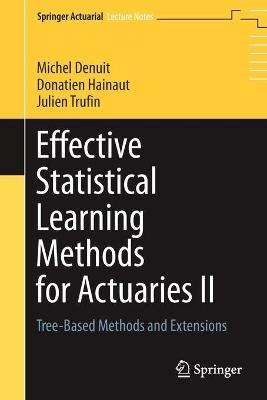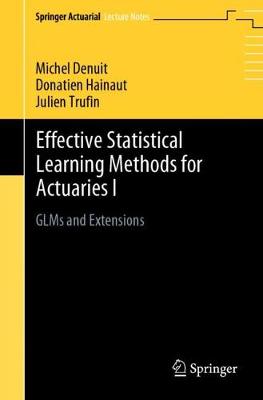Springer Actuarial
3 total works
Effective Statistical Learning Methods for Actuaries II
by Michel Denuit, Donatien Hainaut, and Julien Trufin
This book summarizes the state of the art in tree-based methods for insurance: regression trees, random forests and boosting methods. It also exhibits the tools which make it possible to assess the predictive performance of tree-based models. Actuaries need these advanced analytical tools to turn the massive data sets now at their disposal into opportunities.
The exposition alternates between methodological aspects and numerical illustrations or case studies. All numerical illustrations are performed with the R statistical software. The technical prerequisites are kept at a reasonable level in order to reach a broad readership. In particular, master's students in actuarial sciences and actuaries wishing to update their skills in machine learning will find the book useful.
This is the second of three volumes entitled Effective Statistical Learning Methods for Actuaries. Written by actuaries for actuaries, this series offers a comprehensive overview of insurance data analytics with applications to P&C, life and health insurance.
Effective Statistical Learning Methods for Actuaries I
by Michel Denuit, Donatien Hainaut, and Julien Trufin
This book summarizes the state of the art in generalized linear models (GLMs) and their various extensions: GAMs, mixed models and credibility, and some nonlinear variants (GNMs). In order to deal with tail events, analytical tools from Extreme Value Theory are presented. Going beyond mean modeling, it considers volatility modeling (double GLMs) and the general modeling of location, scale and shape parameters (GAMLSS). Actuaries need these advanced analytical tools to turn the massive data sets now at their disposal into opportunities.
The exposition alternates between methodological aspects and case studies, providing numerical illustrations using the R statistical software. The technical prerequisites are kept at a reasonable level in order to reach a broad readership.
This is the first of three volumes entitled Effective Statistical Learning Methods for Actuaries. Written by actuaries for actuaries, this series offers a comprehensive overview of insurance data analytics with applications to P&C, life and health insurance. Although closely related to the other two volumes, this volume can be read independently.
Effective Statistical Learning Methods for Actuaries III
by Michel Denuit, Donatien Hainaut, and Julien Trufin
This book reviews some of the most recent developments in neural networks, with a focus on applications in actuarial sciences and finance. It simultaneously introduces the relevant tools for developing and analyzing neural networks, in a style that is mathematically rigorous yet accessible.
Artificial intelligence and neural networks offer a powerful alternative to statistical methods for analyzing data. Various topics are covered from feed-forward networks to deep learning, such as Bayesian learning, boosting methods and Long Short Term Memory models. All methods are applied to claims, mortality or time-series forecasting.
Requiring only a basic knowledge of statistics, this book is written for masters students in the actuarial sciences and for actuaries wishing to update their skills in machine learning.This is the third of three volumes entitled Effective Statistical Learning Methods for Actuaries. Written by actuaries for actuaries, this series offers a comprehensive overview of insurance data analytics with applications to P&C, life and health insurance. Although closely related to the other two volumes, this volume can be read independently.


